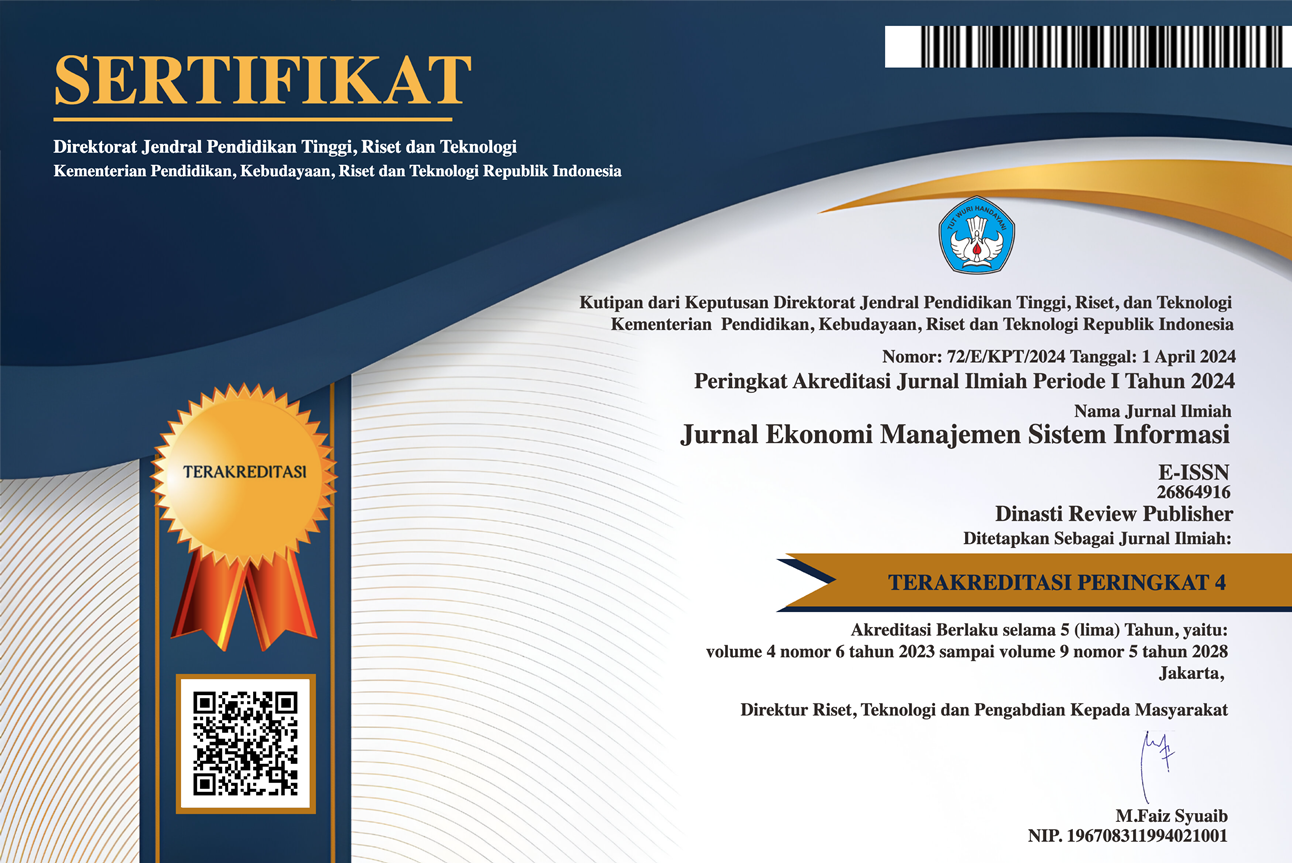Pengaruh Beban Kerja, Effort Reward Imbalance, Person Environment Fit Terhadap Turnover Intention Perawat Di Rumah Sakit Permata Keluarga Lippo Cikarang Dengan Stres Kerja Sebagai Variabel Intervening
DOI:
https://doi.org/10.38035/jemsi.v6i4.4813Keywords:
Beban Kerja, Effort Reward Imbalance, Person Environment Fit, Work Stress, Turnover IntentionAbstract
Turnover di kalangan perawat dapat mengganggu kinerja rumah sakit yang telah berjalan bagus. Kerugian dari turnover yang tinggi juga adalah kerugian finansial, karena biaya untuk karyawan adalah 60% dari biaya keseluruhan rumah sakit. Penelitian ini bertujuan untuk menguji pengaruh beban kerja, effort-reward imbalance, serta person environment fit terhadap turnover intention dengan stres kerja sebagai variabel intervening. Pendekatan yang digunakan dalam penelitian ini adalah penelitian kuantitatif dengan pendekatan cross-sectional. Sampel yang digunakan dalam penelitian ini adalah seluruh perawat yang memberikan pelayanan pada pasien yang berjumlah 126 responden. Data penelitian diperoleh dari hasil pengisian kuesioner dan dianalisis dengan menggunakan teknik analisis PLS SEM. Hasil penelitian ini menunjukkan bahwa stres kerja tidak mampu memediasi pengaruh beban kerja, effort-reward imbalance, serta person-environment fit terhadap turnover intention, beban kerja tidak berpengaruh signifikan terhadap stres kerja, effort-reward imbalance tidak berpengaruh signifikan terhadap stres kerja, person-environment fit tidak berpengaruh signifikan terhadap stres kerja, beban kerja berpengaruh positif dan signifikan terhadap turnover intention, effort-reward imbalance berpengaruh positif dan signifikan terhadap turnover intention, person-environment fit berpengaruh negatif dan signifikan terhadap turnover intention, stres kerja berpengaruh positif dan signifikan terhadap turnover intention.
References
Amarneh, S., Raza, A., Matloob, S., Alharbi, R. K., & Abbasi, M. A. (2021). The Influence of Person?Environment Fit on the Turnover Intention of Nurses in Jordan: The Moderating Effect of Psychological Empowerment. Nursing Research and Practice, 2021(1), 6688603.
Budiyanto, B., Rattu, A. J. M., & Umboh, J. M. L. (2019). Faktor-Faktor Yang Berhubungan Dengan Stres Kerja Perawat Pelaksana Di Ruang Rawat Inap Rumah Sakit Umum Bethesda Gmim Tomohon. KESMAS: Jurnal Kesehatan Masyarakat Universitas Sam Ratulangi, 8(3).
Chin, W. W. (1998). The partial least squares approach to structural equation modeling. Modern Methods for Business Research, 295(2), 295–336.
Dartey, A. F., Tackie, V., Worna Lotse, C., Dziwornu, E., Affrim, D., & Delanyo Akosua, D. R. (2023). Occupational stress and its effects on nurses at a health facility in Ho Municipality, Ghana. SAGE Open Nursing, 9, 23779608231186044.
Dhania, D. R. (2012). Pengaruh stres kerja, beban kerja, terhadap kepuasan kerja (studi pada medical representatif di kota kudus). Jurnal Psikologi: PITUTUR, 1(1), 15–23.
Diniaty, D. D. (2016). Analisis Beban Kerja Fisik dan Mental Karyawan di Lantai Produksi pada PT Pesona Laut Kuning. SITEKIN: Jurnal Sains, Teknologi Dan Industri, 13(2), 203–210.
Engkus, E. (2019). Pengaruh Kualitas Pelayanan Terhadap Kepuasan Pasien Di Puskesmas Cibitung Kabupaten Sukabumi. Jurnal Governansi, 5(2), 99–109.
Faeni, D. P., Syeikholbi, D., & Husada, C. (2023). Workload and Work Stress Toward Nurses’ Performance at Indonesian General Hospital. Dinasti International Journal of Management Science (DIJMS), 4(5).
Gillies, D. A. (1994). Nursing management: A systems approach. (No Title).
Gorgievski, M. J., Van der Heijden, B. I. J. M., & Bakker, A. B. (2019). Effort-reward imbalance and work-home interference: a two-wave study among European male nurses. Work & Stress, 33(4), 315–333.
Hackman, J. R., & Oldham, G. R. (1976). Motivation through the design of work: Test of a theory. Organizational Behavior and Human Performance, 16(2), 250–279.
Hair, J. F., Babin, B. J., Anderson, R. E., & Black, W. C. (2022). Multivariate Data Analysis. Cengage Learning. https://books.google.co.id/books?id=PONXEAAAQBAJ
Hariyanto, D., Soetjipto, B. E., & Sopiah, S. (2022). The Influence of Workload and Environment on Turnover Intention Through Job Satisfaction and Organizational Commitment. PENANOMICS: International Journal of Economics, 1(3), 335–346.
Jiang, N., Zhang, H., Tan, Z., Gong, Y., Tian, M., Wu, Y., Zhang, J., Wang, J., Chen, Z., & Wu, J. (2022). The relationship between occupational stress and turnover intention among emergency physicians: a mediation analysis. Frontiers in Public Health, 10, 901251.
Karasek Jr, R. A. (1979). Job demands, job decision latitude, and mental strain: Implications for job redesign. Administrative Science Quarterly, 285–308.
Kokoroko, E., & Sanda, M. A. (2019). Effect of workload on job stress of Ghanaian OPD nurses: The role of coworker support. Safety and Health at Work, 10(3), 341–346.
Kristof?Brown, A. L., Zimmerman, R. D., & Johnson, E. C. (2005). Consequences OF INDIVIDUALS’FIT at work: A meta?analysis OF person–job, person–organization, person–group, and person–supervisor fit. Personnel Psychology, 58(2), 281–342.
Lee, E., & Kim, J. (2020). Nursing stress factors affecting turnover intention among hospital nurses. International Journal of Nursing Practice, 26(6), e12819.
Lestari, W. M., Liana, L., & Aquinia, A. (2020). Pengaruh stres kerja, konflik kerja dan beban kerja terhadap kinerja karyawan. Jurnal Bisnis Dan Ekonomi, 27(2), 100–110.
Liu, Y., Duan, Y., & Guo, M. (2023). Turnover intention and its associated factors among nurses: a multi-center cross-sectional study. Frontiers in Public Health, 11, 1141441.
Mariati, L. H., & Rambing, E. (2019). Hubungan konflik peran ganda dengan kinerja perawat wanita di puskesmas dampek kabupaten Manggarai timur tahun 2019. Jurnal Wawasan Kesehatan, 4(1), 41–50.
Mobley, W. H., Horner, S. O., & Hollingsworth, A. T. (1978). An evaluation of precursors of hospital employee turnover. Journal of Applied Psychology, 63(4), 408.
Muslim, A., & Sutinah, S. (2020). Pengembangan Karier Profesional Perawat Non PNS Di Rumah Sakit X. Jurnal Manajemen Kesehatan Yayasan RS. Dr. Soetomo, 6(1), 16–27.
North, N., Leung, W., Ashton, T., Rasmussen, E., Hughes, F., & Finlayson, M. (2013). Nurse turnover in New Zealand: costs and relationships with staffing practises and patient outcomes. Journal of Nursing Management, 21(3), 419–428.
Ramie, A. (2022). Perkembangan Rumah Sakit Di Indonesia Di Era Distruptif. Junal Keperawatan.
Reid, G. B., & Nygren, T. E. (1988). The subjective workload assessment technique: A scaling procedure for measuring mental workload. In Advances in psychology (Vol. 52, pp. 185–218). Elsevier.
Rindu, R., Lukman, S., Hardisman, H., Hafizurrachman, M., & Bachtiar, A. (2020). The relationship between transformational leadership, organizational commitment, work stress, and turnover intentions of nurse at private hospital in Indonesia. Open Access Macedonian Journal of Medical Sciences, 8(E), 551–557.
Roshanger, F., Davoudi, B., Hasankhani, H., & Babapour, J. (2018). The relationship between the efford–reward imbalance and psychosocial health in nurses. Journal of Research in Medical and Dental Sciences, 6(2), 67–73.
Sandianto, S., Tualeka, A. R., & Indriani, D. (2018). The effect of workload on the job stress of nurses in outpatient care unit of public hospital Surabaya, Indonesia. Indian Journal of Public Health Research & Development, 9(1), 80–84.
Sarafis, P., Rousaki, E., Tsounis, A., Malliarou, M., Lahana, L., Bamidis, P., Niakas, D., & Papastavrou, E. (2016). The impact of occupational stress on nurses’ caring behaviors and their health related quality of life. BMC Nursing, 15, 1–9.
Siegrist, J. (2016). Effort-reward imbalance model. In Stress: Concepts, cognition, emotion, and behavior (pp. 81–86). Elsevier.
Siegrist, J., & Li, J. (2017). Work stress and altered biomarkers: a synthesis of findings based on the effort–reward imbalance model. International Journal of Environmental Research and Public Health, 14(11), 1373.
Smith, B., & Rutigliano, T. (2002). The truth about turnover. Business Journal,[Online]. Available at:< Http://Www. Gallup. Com/Businessjournal/316/Truth-about-Turnover. Aspx>[Accessed 16 January 2017].
Sukesi, N., Listiyani, N., Winarti, R., & Wahyuningsih. (2024). The Relationship of Workload and Job Stress in Nurses in the Patient Room. East Asian Journal Of Multidisciplinary Research, 3(3), 1341–1348. https://journal.formosapublisher.org/index.php/eajmr/article/view/8539
Van Vegchel, N., De Jonge, J., Bosma, H., & Schaufeli, W. (2005). Reviewing the effort–reward imbalance model: drawing up the balance of 45 empirical studies. Social Science & Medicine, 60(5), 1117–1131.
Wibowo, A., Setiawan, M., & Yuniarinto, A. (2021). The effect of workloads on turnover intention with work stress as mediation and social support as moderated variables. Jurnal Aplikasi Manajemen, 19(2), 404–412.
Wyatt, W. (2007). Playing to win in a global economy: Global strategic rewards report and United States findings. Watson Wyatt Worldwide.
Downloads
Published
How to Cite
Issue
Section
License
Copyright (c) 2025 Paul Yoke Limuria, Rian Adi Pamungkas, Tjipto Rini

This work is licensed under a Creative Commons Attribution 4.0 International License.
Hak cipta :
Penulis yang mempublikasikan manuskripnya di jurnal ini menyetujui ketentuan berikut:
- Hak cipta pada setiap artikel adalah milik penulis.
- Penulis mengakui bahwa Jurnal Ekonomi Manajemen Sistem Informasi (JEMSI) berhak menjadi yang pertama menerbitkan dengan lisensi Creative Commons Attribution 4.0 International (Attribution 4.0 International CC BY 4.0) .
- Penulis dapat mengirimkan artikel secara terpisah, mengatur distribusi non-eksklusif manuskrip yang telah diterbitkan dalam jurnal ini ke versi lain (misalnya, dikirim ke repositori institusi penulis, publikasi ke dalam buku, dll.), dengan mengakui bahwa manuskrip telah diterbitkan pertama kali di Jurnal Ekonomi Manajemen Sistem Informasi (JEMSI).











































































